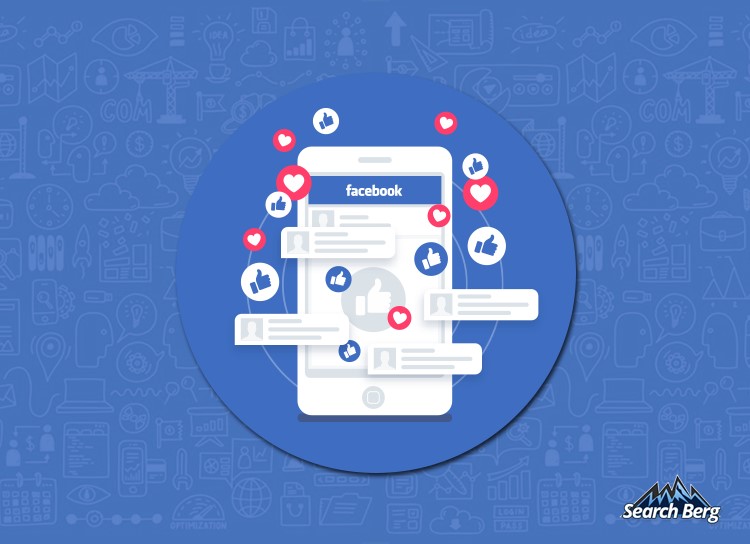How to Market Your Business on Facebook in 2023
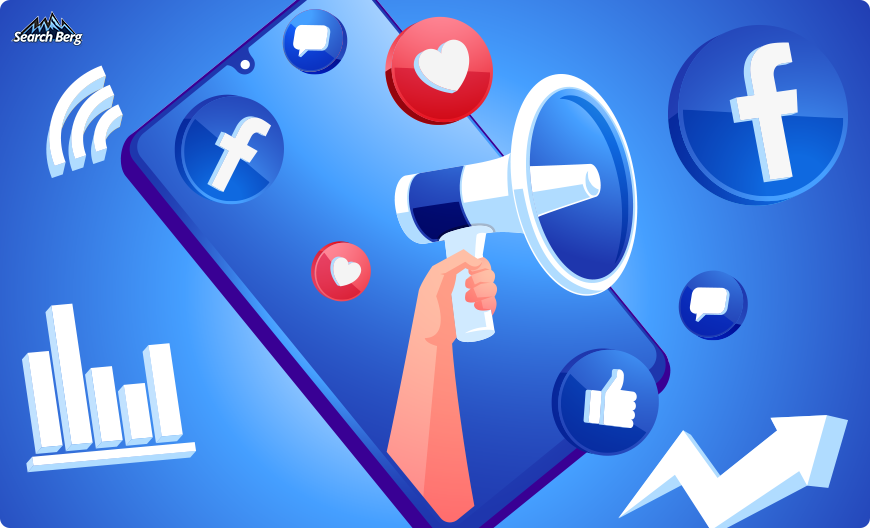
Once upon a digital era, business owners would ask, “Hey, do you have a website?” Now, the burning question has evolved to, “Hey, how’s your Facebook marketing game?”
Let’s face it: if you’re not wooing clients on this social giant, you’re missing a chunk of virtual footfall that could be singing praises for your brand. And by a chunk of virtual footfall, we mean a whopping three billion monthly active users.
Want these people to come knocking at your door? We’re about to show you the way.
Join us as we delve deep into the world of Facebook, where reactions can indeed be converted to transactions and where your brand’s story becomes the talk of the virtual town. You’ll learn why Facebook is important for marketing, the right way to leverage Facebook for company marketing, correct business use for Facebook, and a lot more.
1. Understand Your Audience with Analytics
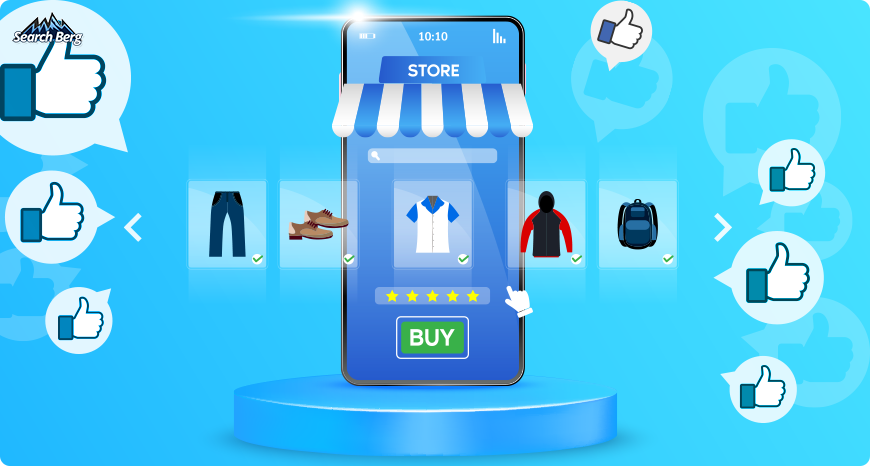
Imagine running a store where you greet every customer, but your words keep missing the mark. They glance around and leave while you’re left wondering, “What did I miss?”
That’s what it feels like to be on Facebook without truly understanding your audience. Every post feels like a shot in the dark.
For business owners navigating the vast and sometimes overwhelming world of Facebook marketing, developing a clear understanding of who you’re speaking to can be a game-changer. It’s the difference between shouting blindly in a packed stadium and having a meaningful one-on-one conversation.
This is where analytics enter the picture. This isn’t just another helping hand; it’s your guidebook, translator, and secret weapon in this journey. Before we tap into its power, we need to begin at square one: demographics.
1.1. A Deep Dive Into Demographics
At their very core, demographics are the basic attributes and characteristics that define your audience. Think of them as the foundational layers of a painting: the broad strokes that set the tone for the intricate details to come.
Without a good grasp of demographics, you’ll struggle to learn and master the ropes of Facebook for company marketing.
In the realm of analytics, demographics provide an overview of the age groups, genders, locations, languages, and devices your audience gravitates toward.
For instance, let’s consider Jennie’s Boutique, a hypothetical local business selling handcrafted jewelry. By diving into analytics, Jane discovers that 70% of her target audience is women aged between 25 and 34; they primarily hail from New York and access her page via mobile devices.
This information is golden.
Now, instead of casting a wide net, Jane can tailor her posts, ads, and even her jewelry collections to cater more directly to this demographic. She could design mobile-optimized advertisements (perhaps even incorporating New York themes into her jewelry line or collaborating with local influencers in that age bracket). This isn’t just regular Facebook marketing; it’s precise, clever, and quite simply masterful business use for Facebook.
Understanding demographics also assists in eliminating wasted effort when it comes to social media marketing with Facebook. For instance, if a significant portion of your audience doesn’t speak Spanish, prioritizing English content may be more efficient. Conversely, if a chunk of your audience accesses your page from Android devices, ensuring compatibility and optimizing for that platform becomes paramount.
This is an excellent way to squeeze maximum juice out of your fresh, fragrant, and sweet Facebook marketing lemons.
Now, how do you go about the analytics game? Up until July 1, 2021, Facebook boasted its own ingenious platform, “Facebook Analytics”. Since its departure, the analytics feather has been placed in digital marketing companies’ caps instead.
If you want to obtain a complete picture of demographics, turn to an experienced social media management company that specializes in Facebook marketing, management, and advertising. Search Berg is that company for you.
We use cutting-edge analytics tools to help you understand your audience and make the right moves accordingly. When you know exactly who your audience is, what it wants, what it doesn’t want, and how it makes decisions, your efforts won’t go to waste. Instead, you’ll walk away with terrific reach, enviable sales, and stupefying growth.
Sweet, right?
1.2. Behavioral Insights
Beyond just knowing who your audience is, understanding their behavior is key.
- How often do they interact with your content?
- At what times are they most active?
- Do they prefer videos, images, or written content?
With a power-packed analytics tool, you can map out the user journey, from the moment they see your post to the point they decide to make a purchase or sign up.
1.3. Segmentation for Precision
What lies at the heart of effective Facebook marketing? The ability to deliver the right message to the right person at the right time.
But in the vast digital cosmos that is Facebook, with its billions of diverse users, how does one achieve this precision? The answer is customer segmentation.
Segmentation is akin to sieving through the sands of your audience and grouping similar grains together. It involves categorizing your audience into smaller, more specific groups based on shared characteristics or behaviors.
These groups could be based on anything from geographic location to purchasing behavior or even engagement levels with past content.
Segmentation is invaluable because it allows for personalized marketing. For instance, rather than sending a generic advertisement to all followers, a business can target ads specifically to users who’ve shown interest in a particular product or service. This customization can significantly enhance return on investment because tailored messages often resonate more deeply and are more likely to spur action.
Additionally, segmentation allows businesses to nurture different segments of their audience differently. Consider a new user versus a loyal, long-time follower. While the former might benefit from introductory offers or informational content, the latter could be more responsive to loyalty discounts or advanced product features. By segmenting these audiences, a business can cater to both, meeting them where they are in their respective customer journeys.
But segmentation isn’t just about sales and conversion; it’s also about building lasting relationships. Understanding and addressing the unique needs, preferences, and challenges of each segment fosters a sense of understanding and trust. When customers feel seen and heard, they’re more likely to engage, trust, and remain loyal to a brand.
How can you benefit from the power of segmentation? You guessed it: analytics. Turn to social media management services that are known for their exceptional analytics tools.
Before you do this, learn how to use Facebook for marketing at a basic level. A foundational understanding will help you determine whether you’re partnering with the right company.
If you walk in blindly, you’ll easily get impressed with whatever they throw your way, even if it’s a low-effort marketing plan. Previous knowledge (albeit minimal) will go a long way in helping you select the right social media management company for your unique requirements.
1.4. Conversion Tracking
In the labyrinth of digital marketing, businesses often face a pressing question: are our efforts bearing fruit?
It’s not just about how many users see an advertisement or engage with a post; it’s about the tangible outcomes, i.e., conversions.
Conversion tracking is the beacon that shines a light on this critical aspect. It helps businesses measure the true efficacy of their Facebook marketing strategies.
Every action a user takes after interacting with your content or advertisement, be it signing up for a newsletter, making a purchase, downloading an app, or even just clicking on a link, can be considered a conversion.
However, the trick is determining which actions align with your business goals. For an eCommerce brand, a successful conversion may be a completed sale, while for a media company, it may be a new subscription or newsletter sign-up.
![]()
Meta Pixel (previously known as Facebook Pixel) is an excellent tool in this arena. It’s a piece of code embedded on a website that tracks user interactions after they click on a Facebook advertisement.
When a user performs a desired action on a website, Meta Pixel is triggered and starts recording the conversion. Over time, this data aggregates to provide a holistic view of how well your Facebook ads are driving desired outcomes.
But the magic of conversion tracking isn’t just in the numbers. It’s in the insights that come with them. By analyzing conversion data, businesses can discern which advertisements or content pieces are most effective, which audience segments are most responsive, and even which times of day yield the highest conversions.
This is a great way to identify areas of friction or drop-offs in the user journey and, of course, highlight opportunities for improvement.
If you want to benefit from social media marketing with Facebook in 2023, turning to a power-packed analytics tool should be your first step. You can’t master a social media platform when you don’t even understand your audience. Analytics will help you become buddies with your audience and put on a show they actually want to watch.
Check this box off the list, and you’ve already done most of the work! Skip this step, and you’ll keep wondering why your efforts aren’t bearing fruit.
Recommended Read: How to Get More Likes on Facebook
2. Chatbots: Your 24/7 Digital Concierge
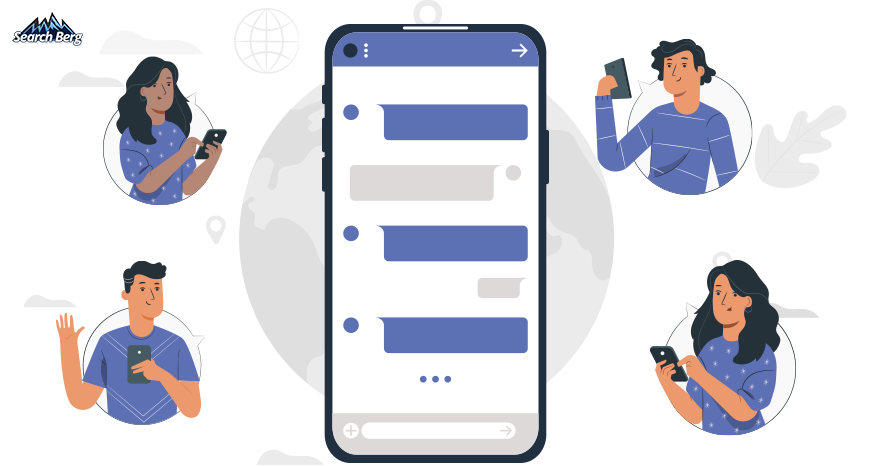
Chatbots, once a novelty in the digital landscape, have rapidly matured into essential tools for businesses (especially on platforms like Facebook).
With the growing need for real-time responses and personalized experiences, chatbots give businesses a way to foster better engagement, answer queries instantly, and guide users through a tailored customer journey on Facebook.
At Search Berg, we believe that social media marketing with Facebook is incomplete without a power-packed, active, and alert chatbot.
2.1. The Power of Immediacy and Trust
Immediacy isn’t just desired; it’s expected. As consumers become more connected, their tolerance for waiting has significantly dwindled. This shift in consumer behavior highlights why Facebook is important for marketing and the need for businesses to be available round the clock (particularly on platforms like Facebook, where users are active at all hours).
Chatbots, in this context, are more than just digital helpers; they’re an integral part of a comprehensive Facebook marketing business strategy. They stand sentinel, always alert and ready to assist, inform, and engage.
Today, most online interactions on social media are driven by impulse. A user’s curiosity may be ignited while scrolling through their feed, and in that moment, they demand answers. This is where chatbots excel.
By providing instant responses to questions about product details, availability, or pricing, they can harness this heightened interest and potentially drive a sale.

Chatbots are also adept at reducing cart abandonment (a challenge many online businesses grapple with). In many cases, potential sales are lost because of uncertainties: maybe a user is unclear about product sizing, shipping costs, or return policies.
In such scenarios, chatbots become an essential tool in the social media marketing with Facebook toolkit. They quickly step in to dispel doubts and increase the likelihood of conversion. They can also be configured to detect hesitation, like a user pausing on the checkout page, and can proactively offer assistance.
But beyond convenience, chatbots play a pivotal role in building trust. Trust is a cornerstone of any business-customer relationship. And nothing erodes trust faster than inconsistency or unresponsiveness.
Chatbots ensure that every user, regardless of when they interact with a business, receives a consistent level of service. This uniformity in response time and quality fosters trust. Users know that whether they have a question at 2 p.m. or 2 a.m., they can rely on the business to assist them.
Of course, chatbots have their limitations. While they’re powerful, they aren’t infallible. Complex queries or nuanced concerns might be beyond their programming.
However, a well-designed chatbot can recognize its limitations. If a user’s inquiry can’t be resolved by the bot, it can smoothly escalate the issue, either by redirecting the user to a human representative or scheduling a callback.
Social media marketing with Facebook becomes so much easier, smoother, and more effective when a chatbot is taking care of customer interactions and automating responses.
2.2. How to Market Your Business on Facebook Using Chatbots
Chatbots have moved from the periphery to the forefront of social media marketing with Facebook. If you’re a business owner wondering how to make the best use of chatbots for Facebook marketing, use this guide to navigate the waters:
- Define Clear Objectives: Before diving into chatbot development, determine what you want the bot to achieve. Do you want it to drive sales, offer customer support, or perhaps engage users with interactive content? Setting clear goals will shape your chatbot’s functionality and ensure it meets your business needs.
- Personalize Interactions: Customers appreciate when brands make them feel unique. Design your chatbot to recognize returning visitors, reference past interactions, and provide recommendations based on user history.
This creates a sense of personal attention. The outcome? Higher engagement and conversion rates.
- Integrate with eCommerce: If you run an online store, make your chatbot a part of the shopping experience!
Allow users to browse products, check availability, and even place orders directly through the chat interface. This seamless integration can boost sales and enhance user experience.
- Prompt for Reviews and Feedback: After a purchase or interaction, program your chatbot to ask for reviews or feedback.
This is an excellent way to gain valuable insights. You can also showcase the positive reviews to build trust with potential customers.
- Offer Exclusive Deals: Engage users by offering special deals or discounts through the chatbot. Exclusive offers can incentivize users to interact with the bot and lead to increased sales. A win-win!
- Stay Updated with Trends: Frequently update your chatbot’s script based on trending topics, seasonal events, or new product launches. This will keep the content fresh and relevant to the user.
- Monitor and Iterate: Use analytics to monitor how users are interacting with your chatbot. Identify areas of success and potential improvements.
This is where you need to turn to a team of social media marketing experts. When it comes to using Facebook for company marketing, in-house teams are a risky move.
Turning to a professional social media management company will help you rest assured that you’re benefiting from the expertise and state-of-the-art Facebook marketing tools you need to excel.
- Maintain a Human Touch: While automation is efficient, there are moments when human intervention is necessary. Ensure your chatbot can smoothly redirect users to a human representative when needed.
3. Facebook Ads: The King Reigns Supreme
Facebook ads wore the crown five years ago. They wear the crown today. And they’ll continue to wear the crown ten years down the line.
This isn’t merely about ads; it’s about why Facebook is important for marketing. Their unparalleled reach, sharp targeting capabilities, and flexible budgeting options have revolutionized how businesses connect with their audience.
This is an arena you absolutely cannot ignore. At all.
So, what makes the magic of Facebook marketing with paid ads so spellbinding? Well, everything. Think of the vast expanse of Facebook as a bustling marketplace. Unpaid (regular) posts are like setting up a stall in one corner and hoping that passersby, drawn by their own curiosity, stop and take a look.
While these posts have their place and can organically reach a set number of individuals, solely relying on them is like hoping for serendipity. In the vast realm of social media marketing with Facebook, relying solely on organic reach means your message can often get buried under a plethora of posts in the user’s feed.
Facebook ads don’t come with guesswork; they come with a guarantee. While regular posts queue up in a user’s feed and are served based on Facebook’s mysterious algorithmic brew, ads are designed for visibility.
They appear in strategic positions within feeds, sidebars, and even Facebook Stories. You don’t just have a good chance at capturing attention; you’re guaranteed to capture attention.
How can you master the art of Facebook advertising? Let’s break it down.
- Crystal Clear Objectives: A ship without a compass? That’s an ad without a clear objective. Before even drafting that ad copy or selecting that image, pinpoint your goal.
Do you want to make users aware of your brand, get them to sign up for a newsletter, or push for direct sales? Your objective will shape everything from your call-to-action (CTA) to the metrics you keep an eye on.
- Don’t Just Create Ads; Craft Them: A visually stunning ad isn’t just an eye-catcher; it’s a heart-stealer. Use images that pop, videos that captivate, and words that compel. With millions of ads vying for attention, yours must stand tall and proud.
- Budgets, Bids, and Beyond: Money may not buy happiness, but it sure buys ad space. However, don’t just throw cash and hope it sticks. Start with a modest budget, analyze the results, and adjust accordingly.
And if the word ‘bidding’ sends a shiver down your spine, don’t worry. With Facebook’s savvy yet simple tools, you’ll feel less like you’re in a frenzied auction and more in control.
- Stay Agile, Stay Ahead: If there’s one constant in the realm of digital advertising, it’s change. Carefully review your ad performance everyday. If an ad is soaring, fantastic! If not, tweak it.
Sometimes, even changing an image or adjusting the target demographics can turn an underperforming ad into a star performer.
Recommended Read: How Much Do Facebook Ads Cost in 2023? Exploring the Latest Trends
4. Interactive Polls and Quizzes
Picture a room full of people, all engrossed in their smartphones, scrolling away to eternity. Now, how do you break that spell and make them look up?
Not with a “Hey, listen up!” but with something that piques their curiosity, involves them, and even provides a sprinkle of amusement.
The answer?Interactive polls and quizzes. But why are they so darn effective?
- Engagement Amplified: When you think of social media management with Facebook, interactive content is the magic wand. It’s the siren call in a sea of static content, beckoning users to engage.
Unlike static content, interactive polls and quizzes invite users to take an action, and let’s admit it, who can resist the urge to click on “Which 90s Sitcom Character Are You?”
- Data Goldmine: As users engage with these interactive elements, they voluntarily offer insights into their preferences, behaviors, and opinions. This is first-hand data without the chore of distributing lengthy surveys.
- Shareability Factor: Got an interesting result from a quiz? You’ll want to share it. Disagree with a poll? You’ll want to discuss it. These are prime candidates for virality on social platforms!
4.1. The Fine Art of Crafting and Implementing Polls and Quizzes
Okay, you know polls and quizzes are a goldmine for Facebook marketing by now. But how can you leverage them to make your business stand out on Facebook?
- Ride the Wave of Relevance: It all starts with a question, or in this case, the right question. Let’s say you run a travel agency. Instead of asking, “Which destination is on your bucket list?”, why not delve deeper?
Pose questions like “What’s your ideal travel vibe: mystical mountains or vibrant cities?” This is an excellent way to gauge user preferences and paint vivid mental imagery (a gentle nudge toward future action).
- Brevity is Your Ally: In an age of swipes and scrolls, every second counts. If your quiz feels like an endless journey or your poll looks like a philosophical debate, chances are users will bounce off.
The trick? Craft concise yet compelling content. Think of your content as a quick Facebook marketing business pitch: short, sweet, and to the point!
- Pack a Punch with Value: While frivolous fun can earn clicks, intertwining genuine value can convert casual interactors into potential customers.
A fashion retailer could launch a quiz titled “Find Your Signature Style!”. At the end, users could be shown curated outfits based on their answers, turning passive engagement into active shopping.
- Guide with a Purposeful Call-to-Action (CTA): They’ve taken your poll or quiz; what’s next? This is where a robust CTA comes into play.
Whether you’re encouraging users to explore a new product collection, sign up for an exclusive webinar, or simply share their interactive experience, make sure your CTA is clear, enticing, and unmistakably visible.
- Iterate with Intelligence: One of the fantastic things about digital interactions is the wealth of data they offer. After launching your poll or quiz, don your detective hat!
Examine the metrics. Which segments had users dropping off? Were there certain questions that triggered more engagement? By deciphering these patterns, you can refine your approach. Each iteration should enhance your Facebook marketing business approach.
4.2. Examples
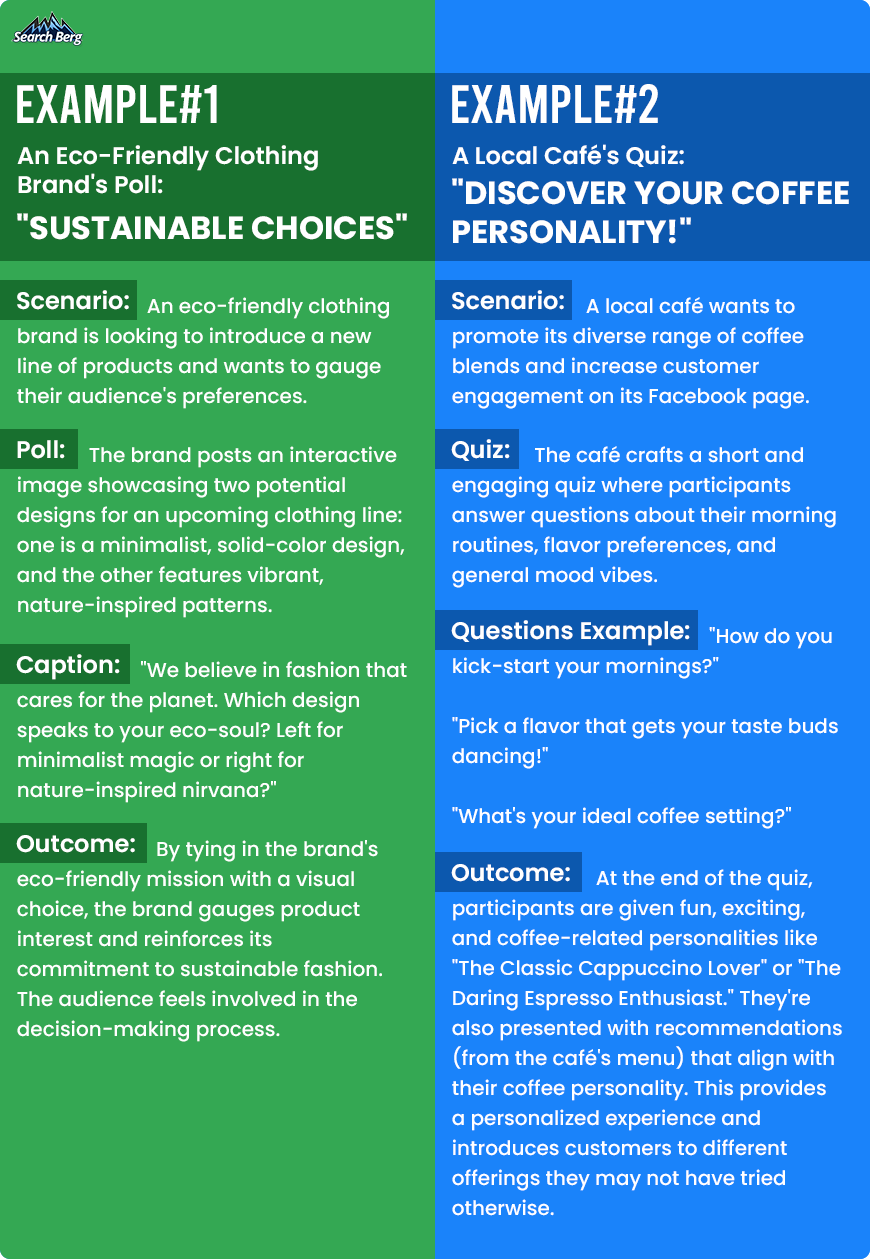
5. Collaborations and Partnerships
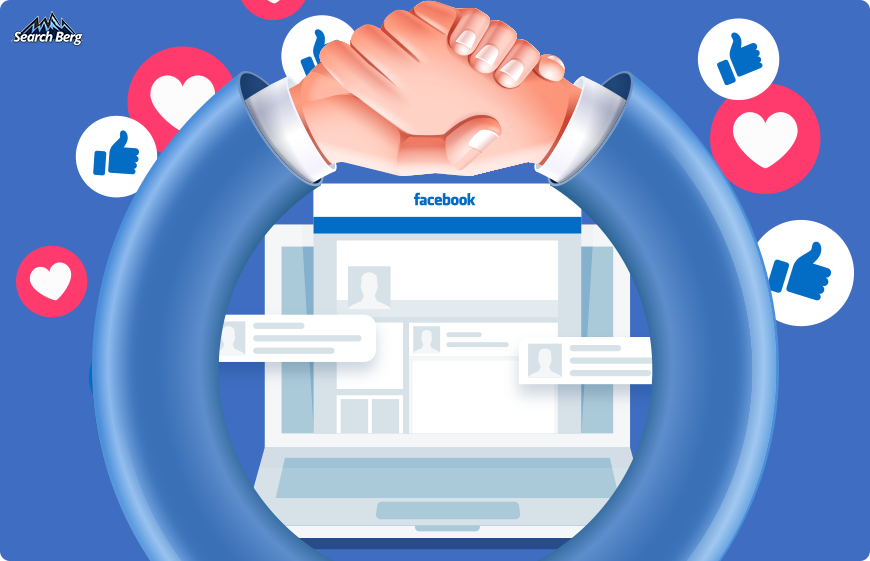
The goal of collaborations and partnerships isn’t just doubling your audience size; it’s primarily diversifying and amplifying your reach.
Let’s say a local artisanal cheese shop partners with a boutique winery for a Facebook Live tasting session. Both businesses tap into each other’s audiences, but more importantly, they create a shared experience that neither could have crafted alone. It’s synergy in its most digital form. We like to call it Facebook magic!
5.1. Charting the Collaborative Course on Facebook
Embarking on a collaborative journey on Facebook isn’t just about posting a joint logo or running a shared campaign. It’s about creating memorable moments, sharing value-added content, and forging a narrative that makes sense to both parties involved.
If done right, collaborations can be a masterclass in how to leverage mutual strengths and tap into combined audiences. But where does one embark on this Facebook marketing business journey? Let’s break it down:
- Identify Synergistic Partners: Every successful collaboration begins with the right pairing. It’s akin to finding the perfect dance partner; both need to be in tune with each other’s rhythm.
On Facebook, this means looking for brands or individuals that have a complementary audience and share similar values, ethos, and goals.
A children’s bookshop might collaborate with a local bakery to run a ‘storytime and cupcakes’ event. A tech company could partner with an online education platform to offer webinars or workshops. The key is to ensure there’s a mutual benefit and a logical connection.
- Forge Genuine Connections: Building a genuine connection is foundational. Instead of solely focusing on mutual gain, turn your attention to mutual respect and understanding.
Before jumping into a partnership proposal, engage with potential collaborators. This means more than just a like or a share; engage with their content, provide genuine feedback, and foster a relationship built on trust.
As the saying goes, people like to collaborate with those they know and trust. A cold pitch without prior interaction can come off as inauthentic and transactional.
- Leverage Facebook’s Features for Collaboration: Facebook is replete with features that can amplify collaborative efforts! Consider co-hosting a Facebook Live session where both brands can interact with a combined audience.
Joint giveaways can be a great way to introduce both sets of followers to each brand; you can incentivize shares, likes, and further engagement.
Shared stories, posts, or even co-created content (like interviews or behind-the-scenes peeks) can provide fresh content for both brands’ followers.
- Set Clear Goals and Terms: Clarity is paramount. Both parties must have a lucid understanding of what the collaboration aims to achieve.
Is the goal to boost page followers? Increase engagement? Promote a joint product or event? Outline the objectives from the get-go.
Additionally, delineate the terms of the partnership: the role of each business, financial implications, the duration of the collaboration, etc. Transparent communication is the bedrock of any successful partnership.
- Celebrate and Evaluate: Once your collaborative endeavor comes to fruition, take a moment to bask in the shared glory. Celebrate your success! At the same time, sit down and evaluate the collaboration’s impact.
Analyzing metrics, understanding what resonated with the audience, and identifying areas of improvement will help lay the groundwork for future partnerships.
Recommended Read: Top 10 Ways to Grow a Small Business Through Facebook
5.2. Successful Collaborations and Partnerships on Facebook
When we discuss stellar collaborations, Red Bull and GoPro’s union stands out as a textbook example of two brands harnessing their unique strengths and shared ethos.
Each of these giants is known for extreme adventure, pushing boundaries, and celebrating the human spirit’s audacity. Their collaboration wasn’t just mutually beneficial; it also resonated with fans on a deeper, aspirational, and motivational level.
Here’s a glimpse:
Red Bull’s thrilling events, like the Red Bull Stratos (where Felix Baumgartner jumped from space to earth), were captured using GoPro cameras. The footage was awe-inspiring; they captured every heart-stopping moment in crystal-clear detail. When shared on Facebook, it wasn’t just about promoting a drink or a camera; it was about sharing a monumental human achievement.
Instead of overt product placements, their collaborations highlighted each brand’s core values and strengths. GoPro showcased its rugged reliability and high-definition capture capabilities, while Red Bull stamped its essence of audacity and thrill.
The brands effectively employed Facebook’s video capabilities, live streams, and interactive features (such as polls and Q&A sessions around events) to engage their audience.
Coca-Cola and WWF’s partnership is another winner in our eyes. When you think of Coca-Cola, an effervescent drink that’s enjoyed worldwide may come to mind. On the other hand, WWF (World Wildlife Fund) evokes thoughts of nature conservation and the preservation of endangered species.
At first glance, they may seem worlds apart, but their collaboration paints a picture of corporate responsibility and global change.
This is what we’re talking about:
The partnership’s central theme was water conservation, particularly in areas threatened by its scarcity. Coca-Cola, a brand synonymous with a beverage, aligned its goals with WWF’s.
Collectively, they emphasized the significance of freshwater sources. The Facebook campaigns revolving around this initiative didn’t just inform; they inspired action.
By utilizing poignant visuals, they showcased areas around the globe facing acute water shortages and the joint initiatives in place to combat this. Images of sprawling landscapes, endangered species, and local communities were interwoven with Coca-Cola’s efforts to reduce its water footprint. The resulting narrative? One of unity and purpose.
Start Dominating Facebook with Search Berg!
Ever pondered why Facebook is important for marketing? Well, where else can you engage with billions with just a click?
Now, with endless business use for Facebook, maneuvering through its intricate alleyways can be quite the challenge. And while everyone claims to know how to use Facebook for marketing, decoding its real potential needs a little something. A sprinkle of Search Berg magic, perhaps?
Transitioning from casual posts to a full-fledged Facebook marketing business strategy isn’t just an upgrade; it’s a revolution. And we’re here to lead it!
At Search Berg, we provide social media management services to help you dominate Facebook (among a plethora of other social media platforms). We help you engage a wider audience, accumulate quite the following, become no stranger to likes and shares, boost conversions, and swiftly grow your business.
Sounds like a plan? Schedule a free consultation today!





